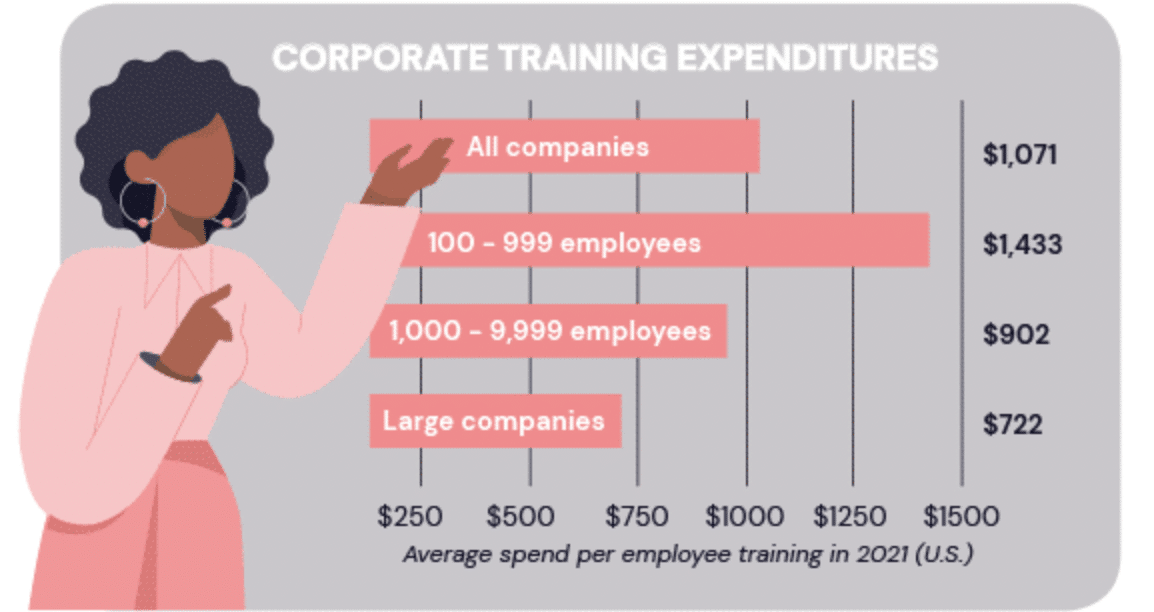According to Training Magazine’s 2021 Training Industry Report, the average company in the U.S. spent $1,071 per employee this year on training costs; that’s $40 less per person compared to 2020.
When you break the numbers down by size of company, they become more interesting. Small companies (100 to 999 employees) decreased their per-person training expense to $1,433 in 2021 from $1,678 in 2020, while mid-size companies (1,000 to 9,999) increased their per person by nearly double, spending $581 in 2020 to $902 in 2021. Large companies also saw a decrease—from $924 in 2020 to $722 in 2021—or about 20 percent.
This article breaks down additional findings from that report in addition to findings from other industry leaders.
The above numbers have been greatly influenced by the COVID-19 pandemic. According to the Training Magazine report, total U.S. training expenditures did increase from $83.5 billion to $92.3 billion. While 2020 initially saw a decrease in total spending, the need for skilled workers and better training throughout 2020 and 2021 resulted in higher expenditures buffered by additional spending on consulting, off-the-shelf and custom content, products, services, and technologies, and by, surprisingly, increased spending on facilities, travel, and equipment.
When you look at these numbers by size of company, the mid-size companies tell an interesting story. Average training expenditures for mid-size companies increased from $808,355 in 2020 to $1.3 million in 2021; large companies saw a decrease in overall training expenditures from $22 million in 2020 to $17.5 million in 2021, while small companies scaled back to the tune of $341,505 in 2021 from their $506,819 spending in 2020.
When asked specifically about what types of training products and services companies expected to purchase next year, online learning tools and systems scored highest, at 35 percent, followed by learning management systems at 34 percent, and content development at 33 percent.

Employee training costs by the numbers
Overall, even while spending less per learner this year, companies provided more hours of training than last year (55.4 hours in 2020; 63.9 in 2021). As previously observed, the size of the company matters. It turns out that large companies actually saw a decrease in overall training hours, going from 102.6 in 2020 to 78.1 in 2021. For their respective parts, mid-size businesses increased from 34.7 hours of training in 2020 to 53.1 in 2021 and small businesses jumped from 41.7 hours to 66.8.
Some context: All of this needs to be considered in light of overall changes in training budgets. Most likely due to the ongoing pandemic, 32 percent of reporting businesses said their training budgets increased in 2021, while 47 percent reported they stayed the same; only 21 percent decreased their budget. When asked why their budgets decreased, cuts due to COVID-19 (76 percent), lower attendance at in-person training events (39%), and decreased outside trainer costs (22 percent) were the primary reasons. When compared to 2020 at 24 percent, only 18 percent of companies with reduced budgets cited decreased staff in 2021—a relief for employers and employees alike.
For companies with increased budgets, their reasons were increasing their scope of training (59 percent), purchasing new technologies and equipment (50 percent), and adding training staff (45 percent). When asked what their highest priorities for training were for 2021, companies responded that their main priorities included the desire to increase training program effectiveness, reduce costs, increase learner usage of programs, and better measure overall impact.
So which departments will get the majority of the training budget next year? Almost a third (31 percent) of respondents said that management and supervisory training is expected to increase, while 23 percent will spend more on interpersonal skills like communication and teamwork. Onboarding will also get a 25 percent bump in projected funding, which makes sense as companies seek to hire and fill gaps left by the pandemic.
Not surprisingly, when companies were asked how much of their training was put on hold during the pandemic in 2021, 13 percent responded that more than 75 percent was put on hold, 25 percent said 1-10 percent of their training was put on the back burner, and 33 percent reported that their training wasn’t affected at all. When asked about the biggest training challenges during the pandemic, the top responses for 2021 were as follows: Getting people engaged in remote learning options was the main challenge for 33 percent of respondents; 24 percent cited a lack of personnel and resources; 16 percent were concerned about converting content to digital formats; and 14 percent reported technology/ramping up to remote training as a main challenge.
How per-employee training costs are calculated
Put simply, you can determine the per-employee training cost by dividing an organization’s training expenditure by the number of employees. But what exactly goes into a company’s learning expenditures? ATD Research, who publishes the yearly State of the Industry Talent Development Benchmarks and Trends, describes it this way:
This figure is composed of talent development (TD) staff salaries (including taxes and benefits), travel costs for TD staff, administrative costs, non salary development costs, delivery costs (such as classroom facilities and online learning technology infrastructure), learning supplier expenses, and tuition reimbursement. It does not include the cost of the learner’s travel or lost work time while engaging in learning activities (2020 State of the Industry, p. 15).
7 strategies for budgeting training
While the cost of employee training can be significant, it’s crucial to remember it’s an investment in your most valuable asset: your workforce. A well-trained team is more productive, engaged, and equipped to achieve your company’s goals. However, navigating training budgets can be tricky.
How much should you allocate? How do you ensure you’re getting the most value from your investment? Here are seven strategies to help you create a realistic training budget aligned with your business objectives.
1. Align training with business goals
Training shouldn’t be a one-size-fits-all approach. Instead, it should be strategically linked to your organization’s specific needs and aspirations. Start by identifying your key business goals. Do you aim to increase sales, improve customer service, or launch a new product line?
Once these goals are defined, assess the skills and knowledge gaps your employees need to bridge to achieve them. This targeted approach ensures your training budget is directed towards programs with the most significant impact on your bottom line.
2. Conduct a training needs assessment
A training needs assessment is an invaluable tool for understanding your workforce’s current skill sets and identifying areas for improvement. This can be achieved through surveys, interviews, skill assessments, or performance reviews.
By pinpointing specific skill gaps, you can prioritize training needs and allocate resources efficiently. For example, if the assessment reveals a lack of proficiency in a new software program crucial for a new product launch, focusing the budget on training related to that software ensures a smoother implementation.
3. Explore cost-effective training options
Training doesn’t have to break the bank. There are numerous cost-effective options to consider:
- E-learning modules: These online courses offer flexibility and affordability, allowing employees to learn at their own pace.
- On-the-job training: Leverage the expertise of senior employees to mentor or train junior colleagues. This fosters knowledge transfer and saves on external training costs.
- Free online resources: A wealth of high-quality online courses and tutorials are available for free. While they may not be as structured as paid programs, they can be a valuable starting point for building foundational skills.
- Government grants: Many government agencies offer grants or subsidies for workforce development programs. Research available options to see if your training initiatives qualify.
4. Leverage technology
A learning management system (LMS) can be a game-changer for managing training programs. These platforms automate course delivery, track employee progress, and provide valuable data for measuring ROI. By streamlining administrative tasks, an LMS frees up resources that can be reinvested into training content or delivery methods.
5. Track and measure ROI
Training is an investment. Like any investment, tracking return on investment (ROI) is crucial. Establish key metrics aligned with your business goals. This could include increased productivity, improved customer satisfaction, reduced error rates, or higher employee retention.
By measuring the impact of training programs, you can demonstrate their value and justify future budget allocations.
6. Embrace blended learning
Blended learning combines different delivery methods to cater to diverse learning styles and maximize effectiveness.
For instance, an instructor-led session can introduce core concepts, followed by interactive eLearning modules for reinforcement, and finally, on-the-job coaching to solidify skills. This approach leverages the strengths of each method while keeping costs in check.
7. Get creative with delivery methods
Think outside the box when it comes to training delivery. Consider gamification, microlearning modules, or peer-to-peer knowledge-sharing sessions.
These creative approaches can boost employee engagement and knowledge retention, all while potentially reducing costs compared to traditional classroom-based training.
How training was delivered
There were some notable trends in how training was delivered in 2021, but those depended heavily on the company size. For small companies, blended learning techniques accounted for 46 percent of delivery methods. Mid-size companies reported blended learning 48 percent of the time, while utilizing virtual training or webcasts 41 percent of the time. Large organizations, however, reported utilizing online or computer-based methods for 32 percent of their training, splitting their other resources between blended and virtual delivery methods (both at 30 percent).
Surprisingly, mobile learning, which has trended upward over the past few years, was not a prioritized delivery method for any size business, accounting for only 7-11 percent of delivery for any size business. Large companies caught on to newer technologies such as artificial intelligence in 2021, reporting that AI accounted for 6 percent of their training delivery. Mid-size and small businesses were slower to catch on to new tech, Nonetheless, all relied on some instructor-led training, with large, mid, and small businesses reporting that training was delivered via instructor 27, 29, and 33 percent of the time, respectively.
With the COVID-19 situation constantly evolving, companies are remaining flexible.. As to what that training will look like post pandemic, 56 percent of companies reported that they will try a hybrid model, with a return to classroom training but keeping some options for remote learning, while only 8 percent will return to solely classroom training. The remainder plan to keep to their pandemic-based remote learning with 17 percent of total respondents adding new content to current curriculum, and 15 percent making no changes.
What do employees want to learn?
Now that we know the trends in per-employee training costs and how training is being delivered, what do companies want their employees to learn? What do employees want to learn? Is there a disconnect between the two?
In a survey of over 500 global professionals by Udemy for Business, it’s clear that upskilling takes top priority and is cause for optimism in the L&D space. As a matter of fact, Udemy reported that 38 percent of the workforce was upskilled in 2020, as compared to 14 percent in 2019. In their 2022 Learning Trends Report, Udemy had surprising insight into what skills employees are most interested in learning in the new year, including a 250 percent increase in the topic of assertive communication and a 129 percent increase in interest around team building as a skill. Soft skills, while once seen as a “nice to have” talent, have become the new must-have for employees looking to level up and make the most of their investment in personal training and development.
According to The PwC Report, “Seventy-nine percent of CEOs worldwide are concerned that a lack of essential skills in their workforce is threatening the future growth of their organization.” In addition to upskilling—and perhaps, as an outgrowth of increased depression and anxiety brought on by the COVID-19 pandemic—employees are asking for mental health and wellness skills such as anxiety management, resilience, and stress management. In the healthcare field alone, consumption of stress management skills training went up by 5,408 percent, according to the Udemy report. Udemy reports that in 2021, employers with wellness programs enjoyed a $3.27 ROI for every dollar spent and employees gained over 10 hours of productivity.
The Udemy 2022 Trends Report also noted that the workforce is demanding skills in time management, focus, and self-discipline, as well as collaborative skills such as listening, business communication, and business writing. The report found that organizations that offer leadership training to all employees were 4.2 percent more likely to outperform in revenue growth, operating margin, and return on equity when compared to those companies that don’t extend that training past the C-suite. The gap between what employees want to learn and what organizations need them to learn—and the anxiety that accompanies it—can be easily closed with a forward-thinking L&D strategy.
According to LinkedIn’s 2020 Workplace Learning Report, the highest priority skills for L&D professionals are leadership and management (57 percent), creative problem solving and thinking (42 percent), and communication (40 percent). All of these trends are telling organizations that, in addition to skills-based learning, a more holistic approach to L&D gives employees more opportunities for growth.
Of course, all of this training takes time from the work day. According to Udemy’s 2021 Trends Report, lack of time is the biggest obstacle to achieving training goals. LinkedIn’s report supports this concern, stating that 49 percent of learners say they don’t have enough time to learn at work. If they had the time, “learners are craving a highly personalized learning experience that serves up the right learning at the right time, without having to dig for it” (p. 26).
Numbers don’t lie; we’re seeing big changes in training costs industry-wide. Post-COVID, some of the changes will stick—most notably, an increase in remote learning. L&D professionals need to pay attention to remote learning trends and what training products and services companies—and employees—are seeking.
Conclusion
While the national average cost of employee training provides a benchmark, a more strategic approach is essential. By aligning training with business goals, conducting training needs analysis, and exploring cost-effective options, you can build a training budget that maximizes your return on investment.
Effective training isn’t just about cost; it’s about empowering your workforce to achieve success and propel your business forward.






